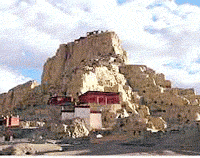
An ancient Tibetan castle encircled by a unique landscape of "earth forest" will compete for the title of World Heritage Site.
Located in what is now Zhaburang Village of Ari Prefecture, the Guge Dynasty remains, which can be traced back more than 1,000 years, has about 1,000 square meters of invaluable frescoes. They feature a typical mixture of Tibetan, Indian, central Asian and European artistic styles and thus are of great value.
The buildings on the site, including more than 300 houses and over 300 grottoes, remain intact, according to Soiba Doje, head of Zanda County, home of the ancient dynasty.
The castle, with an area of some 180,000 square meters that varies from flat to hilly, was designed in three hierarchies -- a magnificent imperial palace, a monastery and civilian housing.
The site is hemmed in by an "earth forest," a sort of woods of standing natural earth columns which extends some 210 square kilometers near the border of China and India.
The "earth forest" stands at an average altitude of more than 4,000 meters.
With gullies, ravines and steep mountainsides, the unique landscape was shaped as a result of gradual geological movements of the Himalayan region ever since the Quaternary Period from 2.5 million years ago and the impact of perennial water erosion and airslaking.
As a historical site under top state protection since 1961, the site of the Guge Dynasty is currently undergoing a major renovation of its environment for the nomination, said Soiba Doje.
A dozen families in the core area of the site have been displaced, according to the county head.
The Guge Dynasty, a major power rising right after the Tubo Dynasty fell apart, was established in the ninth century and lasted more than 700 years.
The civilization was cited by historians as a vivid combination of diversified cultures of Tibet, Chinese Han, India, Nepal and Kashmir. The downfall of the dynasty, however, remains a mystery to archaeologists.
Migmar Cering, director with the cultural bureau of Ari Prefecture, said the special physiognomy of the "earth forest" and Guge Dynasty site are of tremendous value for geological and historical research and thus are qualified to be nominated as World Heritage Site candidates.
(Xinhua News Agency December 3, 2003)
|

